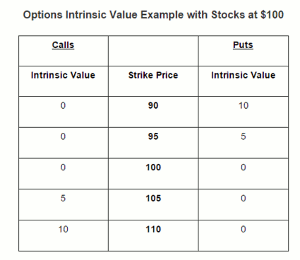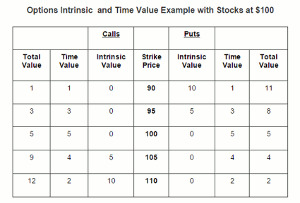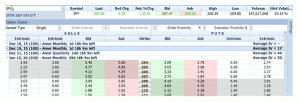One of the interesting properties of options is the way they relate stock prices, interest, and dividends, since, as options instructor Russ Allen, of Online Trading Academy, points out, the option market builds an estimate of dividends into the price of options and they are usually pretty close in that estimate.
There are some fascinating mathematics behind options. If you just read that sentence and don’t see how fascinating and mathematics could ever go together, then options are probably not for you. Otherwise, read on.
One of those interesting properties of options is the way they relate stock prices, interest, and dividends. If we know the prices for options on a stock, we can estimate from those prices what the next dividend payment is likely to be. This is not due to any mystical power of options prices; it is just because the option market builds an estimate of dividends into the price of options and they are usually pretty close in that estimate. If we know how, we can tease it out.
Every option’s price consists of up to two components: intrinsic value and time value.
If the option is in-the-money, it has intrinsic value equal to the amount by which it is in-the-money. If out-of-the-money, it has no intrinsic value. Here are some examples:
In addition to its intrinsic value (if it has any), an option may also have time value. An option’s time value is the total value of the option, minus the intrinsic value (if any). Here is that table again, with option prices and time value added:
Notice that in this example, the time value for the call option at each strike is equal to the time value for the put option at the same strike. For the $90 strike, the time value of both the put and the call is $1. For the $95 strike, it’s $3 for both and so on. In a certain kind of world this relationship would always hold true. This is because the amount of time value in any option is proportional to the probability that the stock could land on that option’s strike price at expiration.
That’s why the time value of the at-the-money option (in this case the $100 strike) is always greater than the time value of any other strike. Where the stock is now is where it has the greatest probability of being at any date in the future. The farther away from its current price the stock has to move to reach another strike, the less chance there is that it will happen and therefore the less time value. Since it’s just as probable for the stock to reach $90 whether we happen to own a $90 put or a $90 call, the time value part of each of the $90-strike options’ value should be the same.
That is, as I said earlier, if we lived in a certain kind of world. That would be a world where interest rates were always zero and stocks never paid dividends. If either non-zero interest or dividends do exist, then they are accounted for in the option prices.
NEXT PAGE: Leading by Dividend Example
|pagebreak|First let’s dispose of interest. The amount of interest that it would cost to borrow an amount of money equal to the strike price until the option’s expiration is built into option prices. Think of it this way: if we owned a call option and wanted to make sure that we had enough money to exercise it if we decided to, we would have to keep that money standing by. That money could otherwise have been invested in T-bills (the risk-free standard in the US). The T-bill interest that we would have earned by investing that strike price has to be built into the call option’s price in order for anyone to be willing to buy the call rather than just invest in T-bills. This is not the most elegant formal description of interest in options, but it gives you the idea: the time value of a call is more than the time value of a put at the same strike by the amount of interest that could have been earned on that strike price. Knowing the T-bill rate, the strike price, and the time to go, we can calculate how much interest could have been earned in that time.
Finally, we come to dividends. If any dividends are to be paid during an option’s lifetime, there is an expectation built into the option prices and that is that the price of the stock will drop by an amount equal to the dividend. When a stock price drops (for any reason), call prices go down and put prices go up. The total of the drop in the call and the increase in the put (at the same strike) adds up to the drop in the stock. In other words, the difference between the put’s value and the call’s value increases by the amount of the drop in the stock. This drop is anticipated in the option prices so that a call’s time value will be reduced compared to a put’s time value at the same strike by the amount of the expected dividend.
And, with this piece of information we have a way to determine how much a dividend is likely to be. If an option has T days to go:
Call time value – interest on the strike price for T days + dividends to be paid = Put time value
Rearranging the formula a little, we get:
Dividends = Put time value – Call time value – interest
We can easily see what the time value is for both the put and call and we can easily calculate the interest amount, so the expected dividends can be calculated.
Here is a real-life example: SPY was scheduled to pay a dividend on December 18. It had options in whose lifetime this would occur which were due to expire 30 days out, on December 18. SPY was near $208 so the 208 options would be the at-the-money options. The interest cost to borrow $208 for thirty days at ¼ % APR would be about $.04. SPY’s option chain looked like this:
The 208 calls had extrinsic value (another word for time value) of $3.03, while that of the 208 puts was $3.81. Now we have what we need to plug into our formula. For the $208 strike:
Dividends expected = Put time value – Call time value – interest
= $3.81 – $3.03 – $.04 = $.74
This amount was somewhat lower than recent quarters’ dividend payments of around $1.00. By the time you read this, the dividend will have been declared and we’ll see how close our estimate was.
If you’ve read this far you are a great candidate for options trading.
By Russ Allen, Instructor, Online Trading Academy
























